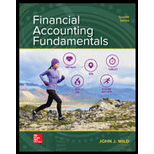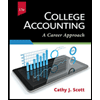
Concept explainers
The accounting equation represents the asset side on the left and liabilities and equity on the right side. The basic principle is that all the assets when debited, are increased, and are decreased when credited.
For liability accounts, it is increased when credited and decreased when debited.
Equity accounts are increased by net profit earned, further capital contribution and decreased by the net loss suffered, dividend distributions and withdrawals.
To Create:
A table summarizing the transactions from a through j in accounting equation format and drawing balances for each account after every transaction occurred.
Answer to Problem 13E
After affecting all the transactions, the balances at the end of the month are as follows:
Cash: $46,000
Equipment: $31,000
Accounts Payable: Nil
Common Stock: $75,000
Dividends: $1,000
Revenues: $10,500
Expenses: $4,500
Explanation of Solution
| Assets | = | Liabilities | + | Equity | |||||||||||||
| Cash | + | Accounts Receivable | + | Equipment | = | Accounts Payable | + | Common Stock | - | Dividends | + | Revenues | - | Expenses | |||
| a | $60,000 | $15,000 | $75,000 | ||||||||||||||
| Balance | $60,000 | $15,000 | $75,000 | ||||||||||||||
| b | $(1,500) | $1,500 | |||||||||||||||
| Balance | $58,500 | $15,000 | $75,000 | $1,500 | |||||||||||||
| c | $10,000 | $10,000 | |||||||||||||||
| Balance | $58,500 | $25,000 | $10,000 | $75,000 | $1,500 | ||||||||||||
| d | $2,500 | $2,500 | |||||||||||||||
| Balance | $61,000 | $25,000 | $10,000 | $75,000 | $2,500 | $1,500 | |||||||||||
| e | $8,000 | $8,000 | |||||||||||||||
| Balance | $61,000 | $8,000 | $25,000 | $10,000 | $75,000 | $10,500 | $1,500 | ||||||||||
| f | $(6,000) | $6,000 | |||||||||||||||
| Balance | $55,000 | $8,000 | $31,000 | $10,000 | $75,000 | $10,500 | $1,500 | ||||||||||
| g | $(3,000) | $3,000 | |||||||||||||||
| Balance | $52,000 | $8,000 | $31,000 | $10,000 | $75,000 | $10,500 | $4,500 | ||||||||||
| h | $5,000 | $(5,000) | |||||||||||||||
| Balance | $57,000 | $3,000 | $31,000 | $10,000 | $75,000 | $10,500 | $4,500 | ||||||||||
| i | $(10,000) | $(10,000) | |||||||||||||||
| Balance | $47,000 | $3,000 | $31,000 | $0 | $75,000 | $10,500 | $4,500 | ||||||||||
| j | $(1,000) | $1,000 | |||||||||||||||
| Balance | $46,000 | $3,000 | $31,000 | $0 | $75,000 | $1,000 | $10,500 | $4,500 | |||||||||
A negative figure in the cash account column represents a decrease in cash, otherwise, all figures represent positive amounts, i.e., increase in cash resources.
At the end of the month, the left side or the asset side has a total of $80,000 (Cash: $46,000; Accounts Receivable: $3,000; Equipment: $31,000)
The total of the right side or the liabilities and equity side have a total of $80,000 (Liabilities: Nil; Equity: $75,000 - $1,000 + $10,500 - $4,500 = $80,000)
Want to see more full solutions like this?
Chapter 1 Solutions
FINANCIAL ACCT.FUND.(LOOSELEAF)
- A machine costing $450,000 has a salvage value of $45,000 and a useful life of 15 years. They expect the machine to produce 675,000 units. In year 1, it produced 60,000 units and in year 2, 42,000 units. Using the units of activity method, what is the depreciation expense in year 2?arrow_forwardPlease explain the solution to this general accounting problem with accurate explanations.arrow_forwardChoice correct answer with accountingarrow_forward
- Principles of Accounting Volume 1AccountingISBN:9781947172685Author:OpenStaxPublisher:OpenStax College
 Pfin (with Mindtap, 1 Term Printed Access Card) (...FinanceISBN:9780357033609Author:Randall Billingsley, Lawrence J. Gitman, Michael D. JoehnkPublisher:Cengage LearningCentury 21 Accounting Multicolumn JournalAccountingISBN:9781337679503Author:GilbertsonPublisher:Cengage
Pfin (with Mindtap, 1 Term Printed Access Card) (...FinanceISBN:9780357033609Author:Randall Billingsley, Lawrence J. Gitman, Michael D. JoehnkPublisher:Cengage LearningCentury 21 Accounting Multicolumn JournalAccountingISBN:9781337679503Author:GilbertsonPublisher:Cengage  College Accounting (Book Only): A Career ApproachAccountingISBN:9781337280570Author:Scott, Cathy J.Publisher:South-Western College Pub
College Accounting (Book Only): A Career ApproachAccountingISBN:9781337280570Author:Scott, Cathy J.Publisher:South-Western College Pub Financial Accounting: The Impact on Decision Make...AccountingISBN:9781305654174Author:Gary A. Porter, Curtis L. NortonPublisher:Cengage Learning
Financial Accounting: The Impact on Decision Make...AccountingISBN:9781305654174Author:Gary A. Porter, Curtis L. NortonPublisher:Cengage Learning





